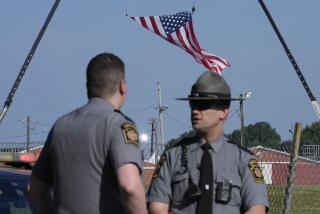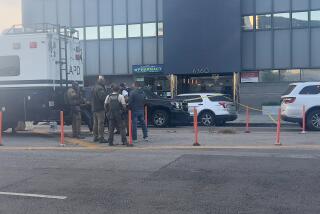Hatred of Police Reportedly Drove Gunman Who Killed 3 Officers in Washington
- Share via
WASHINGTON — The convicted felon who gunned down two FBI agents and a Washington police detective inside police headquarters here was motivated by “a deep hatred for police,” officials said Wednesday as they began a thorough review aimed at improving the building’s security.
A federal official said that the tragedy Tuesday was compounded by indications that the single gunman, Bennie Lee Lawson, 25, who had a record of drug and weapons offenses, did not know his victims personally but was seeking revenge against police.
FBI Director Louis J. Freeh deplored “this senseless violence” aimed at law enforcement officers who had placed “self-risk ahead of their own safety.”
Freeh said in a statement that “the nation can perhaps finally learn there are no longer any sanctuaries from deadly crimes--not even inside a police station.” He said it was “dreadful irony . . . that the victims were part of a nationwide effort by the FBI and local police departments to join forces in cooperative efforts against the worst street crimes and drug trafficking.”
Lawson, whose identity had been withheld previously, died of an apparently self-inflicted gunshot wound in the head, officials said Wednesday. Convicted of weapons violations in 1990 and misdemeanor drug charges in 1993, he was “trying to get back at police who had pulled him in a month ago for questioning” about a more recent triple slaying in the District of Columbia, a federal law enforcement official said.
But Lawson had no reason to be inside police headquarters Tuesday. Instead, he entered the building apparently to take revenge against District of Columbia homicide police, who recently had questioned him, officials said Wednesday. He was unintentionally misdirected to the wrong squad room by other visitors in the building who did not know his purpose.
The slain law enforcement officers were members of a joint federal-city “cold case” homicide unit that tries to solve old murder cases whose trail has grown cold. They were not the homicide officers, located on the same floor, who had questioned Lawson earlier, officials said.
FBI spokeswoman Susan Lloyd said Wednesday that Lawson was carrying a TEC-9 semiautomatic assault weapon slightly larger than a handgun, which fires multiple rounds in seconds. It is among the types banned for future purchase by anticrime legislation approved by Congress last August.
Law enforcement officials said that the threat of revenge from a crime suspect is a risk endemic to their profession. “It’s something you think about. How you prepare for it I don’t know,” said D.C. Officer Anthony O’Leary, who works in the building.
Eugene Cromartie, deputy executive director of the International Assn. of Chiefs of Police, called this danger “a real-world phenomenon that you live with every day.”
In the usually security-conscious capital, visitors to D.C. police headquarters are not required to pass through metal detectors and often are not questioned. But Police Chief Fred Thomas told reporters that he would review such procedures “to see where we need to make changes.”
Thomas added that, “because it’s a public building . . , it’s hard to control access.”
Cromartie said that the police chiefs association has found “there is no standard practice on security at police stations, even in large metropolitan areas, because in buildings where there are other activities you deter the public from coming in.”
In Los Angeles, visitors to Parker Center police headquarters are not screened by metal detectors but must pass by security desks where officers question their business and call ahead to verify destinations. In New York, electronic screening procedures are used.
More to Read
Sign up for Essential California
The most important California stories and recommendations in your inbox every morning.
You may occasionally receive promotional content from the Los Angeles Times.













